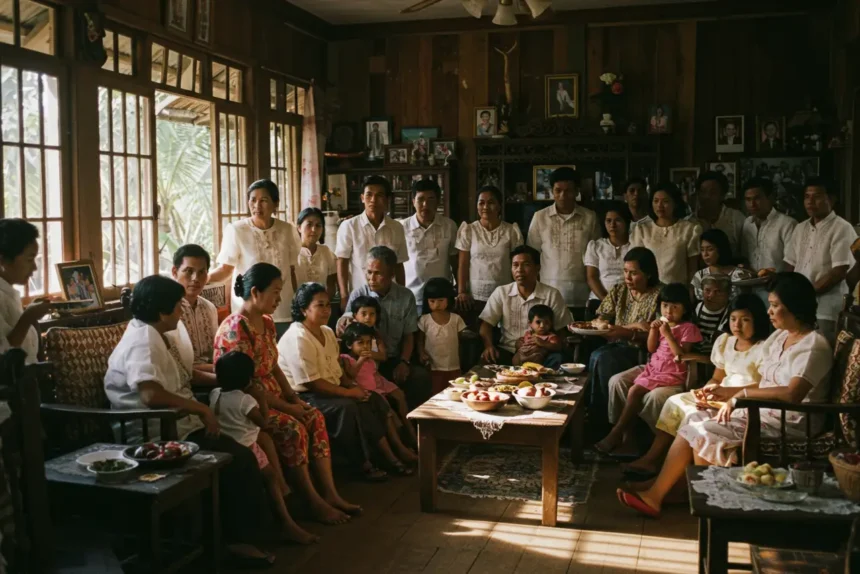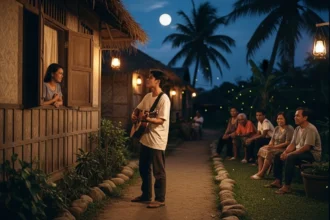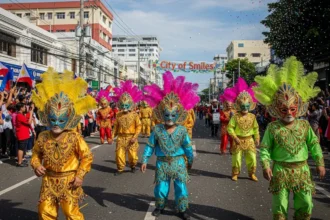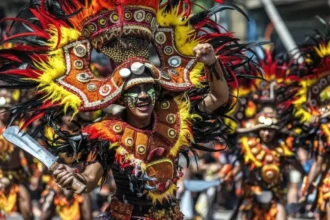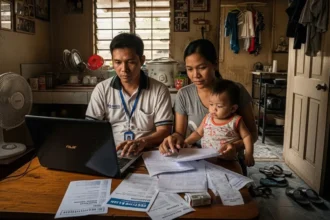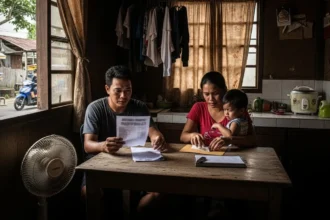There are many things that make us proudly Filipino – our food, our music, our humor, and even the way we celebrate life’s biggest and smallest moments. But nothing captures our soul more than the customs and traditions we continue to practice, whether in the quiet gesture of pagmamano, the joyful chaos of a fiesta, or the simple act of bringing home pasalubong. These aren’t just habits; they are living expressions of who we are.
- 👪 Family-Centered Filipino Customs and Traditions
- 🤝 Community Traditions and the Spirit of Bayanihan
- 💕 Filipino Traditions of Love, Courtship, and Marriage
- 🙏 Festivals, Faith, and Spiritual Traditions in the Philippines
- 🌞 Everyday Filipino Traditions in Daily Life
- 🌏 Why Filipino Customs and Traditions Matter Today
- ❓ FAQs About Filipino Customs and Traditions
- ✨ Living the True Filipino Spirit
- 🧭 References
While our superstitions reveal what we believe about luck, love, and fate, our customs show how we live, love, and connect as a people. They are the threads that tie generations together, reminding us of our roots even in a fast-changing world. And though some may evolve with time, the heart of these traditions remains – a testament to the resilience, warmth, and joy that define the Filipino spirit.
In this article, we’ll celebrate the Filipino customs and traditions that continue to make us feel truly Pinoy – practices that deserve to be passed on, not forgotten.
👪 Family-Centered Filipino Customs and Traditions
In the Philippines, family is more than a unit – it’s the very foundation of society. Many of our most enduring Filipino customs and traditions revolve around family life, shaping how we show respect, how we celebrate milestones, and how we stay connected across generations. These practices are not just rituals; they are powerful reminders of our values of respect, closeness, and belonging.
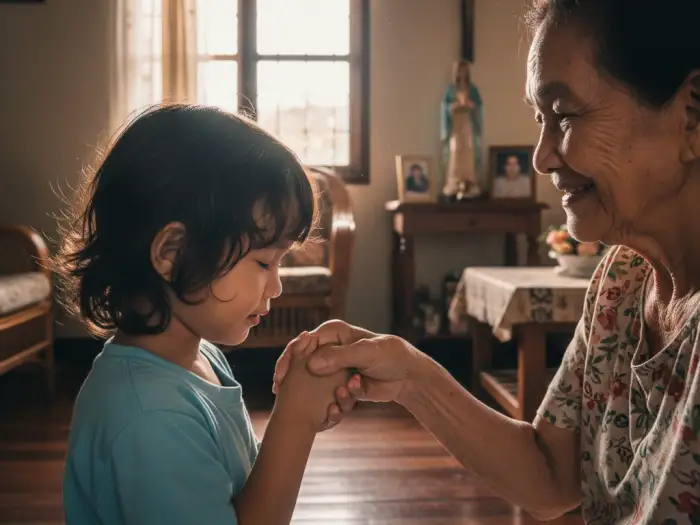
1. Pagmamano and the Use of Po/Opo
One of the most enduring Filipino customs is pagmamano – the act of taking an elder’s hand and gently pressing it to one’s forehead. It’s often accompanied by the phrase “Mano po”, which literally means “your hand, please.” This tradition, rooted in Spanish influence but uniquely Filipino in practice, is a gesture of blessing, humility, and respect.
Equally important is the use of po and opo in conversations. These linguistic markers of courtesy are taught from childhood and used when speaking with parents, grandparents, and anyone older. While some younger Filipinos in urban areas may use them less often, these expressions remain a defining aspect of Filipino politeness and continue to symbolize the deep respect we hold for our elders.
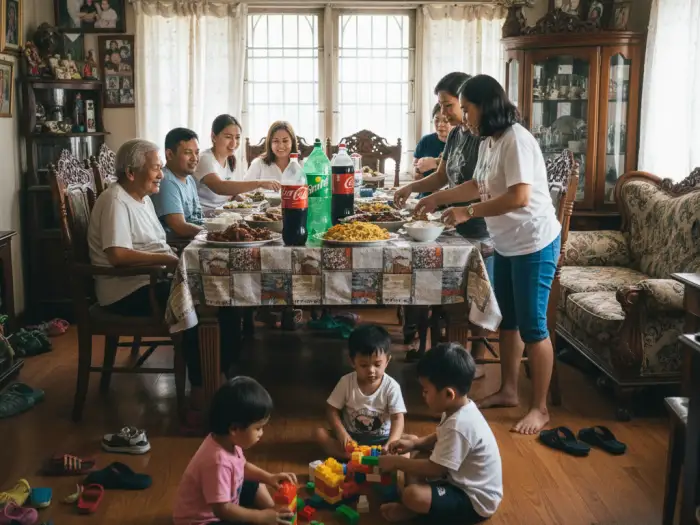
2. Strong Family Ties and Extended Families
Filipino families are known for their close-knit structure, often going beyond the nuclear setup. It’s common to see several generations living under one roof – grandparents caring for grandchildren, aunts and uncles stepping in as second parents, and cousins growing up like siblings. This tradition is shaped by both practical needs and cultural values, where caring for each other is seen as a duty, not a burden.
Unlike in Western countries where children often leave home at 18, many Filipinos stay with their families well into adulthood, either to save money, help support parents, or simply because family bonds are too strong to break easily. Sunday lunches, holiday reunions, and extended gatherings during milestones are more than events; they are living expressions of the Filipino belief that family is forever.
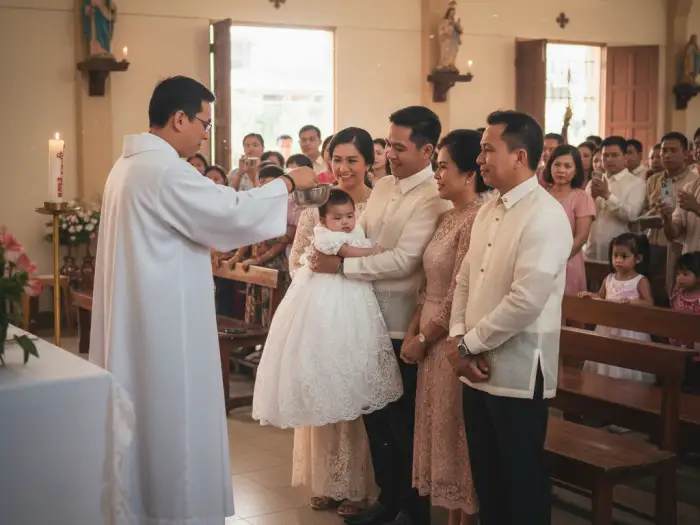
3. The Godparent Tradition (Ninong at Ninang)
The tradition of godparents, or ninong and ninang, is another unique facet of Filipino culture. While originally rooted in Catholic sacraments like baptism and confirmation, the role of godparents has grown beyond religion. A ninong or ninang is expected to provide moral guidance, mentorship, and sometimes even financial support throughout a child’s life.
In Filipino weddings, the number of godparents can be unusually high compared to other cultures – often a dozen or more pairs, reflecting not just spiritual guardianship but also the importance of community ties. For many, the network of godparents becomes a lifelong safety net, a cultural assurance that a child will always have more than one set of “parents” to turn to.
🤝 Community Traditions and the Spirit of Bayanihan
Beyond the family, Filipinos are defined by their strong sense of community. Our towns and barangays come alive through customs and traditions that emphasize cooperation, generosity, and celebration. These practices remind us that no Filipino ever stands alone – we rise and thrive together.
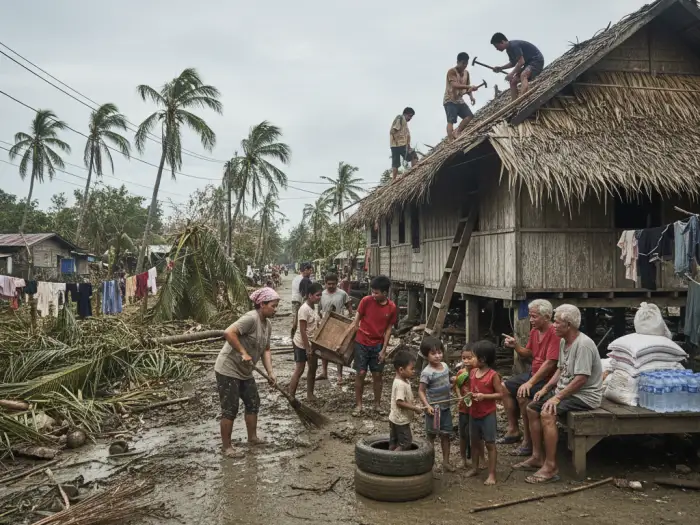
4. Bayanihan as the Heart of Filipino Community Life
Perhaps the most iconic Filipino tradition is bayanihan. The word comes from bayan (town or nation) and refers to the spirit of communal unity. Traditionally, this was literally seen when neighbors would help a family move their bahay kubo (nipa hut) by carrying it together on bamboo poles.
Today, bayanihan is expressed in new ways – from communities pitching in to help rebuild after typhoons, to volunteers organizing medical missions, to neighbors pooling resources for a fiesta. It is more than a custom; it’s the embodiment of the Filipino value of malasakit (genuine concern for others).
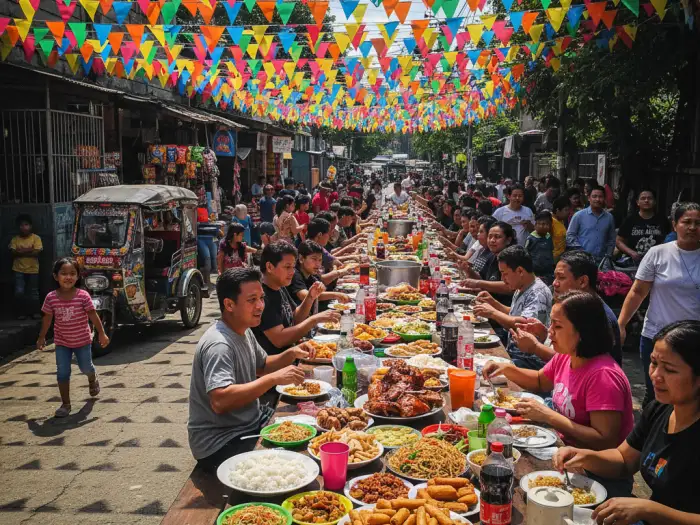
5. Fiesta Culture and Sharing Food
Another beloved tradition is the fiesta, a colorful celebration that often honors a town’s patron saint. These festivals are more than religious events – they are social gatherings where homes are opened to everyone, food is shared without hesitation, and strangers are treated like family.
Lechon, pancit, and kakanin line the tables, and no guest leaves hungry. For many Filipinos, fiestas showcase our pakikisama (harmony with others) and pagkamapagbigay (generosity). Even overseas, Filipino communities recreate fiestas, proving that this custom is one of the most enduring hallmarks of our culture.
6. Filipino Hospitality: Welcoming Guests Like Family
The Philippines is world-renowned for its hospitality, and this reputation comes directly from our customs. Guests – whether relatives from afar, a neighbor dropping by, or even foreigners – are treated with the best a household can offer. It’s common for a Filipino family to serve their finest food, give up the most comfortable bed, or insist that a visitor eat first before anyone else.
This tradition of Filipino hospitality reflects a culture that values warmth and inclusiveness. It doesn’t matter if one lives in a humble home; what matters is that visitors feel cared for. This practice, passed down through generations, continues to be a source of pride and a key part of what makes us uniquely Filipino.
💕 Filipino Traditions of Love, Courtship, and Marriage
Love and family life in the Philippines are not just personal milestones; they are deeply social events, woven with customs that reflect respect, unity, and community. These Filipino traditions show how relationships are nurtured not only between two people but between families and even entire communities.
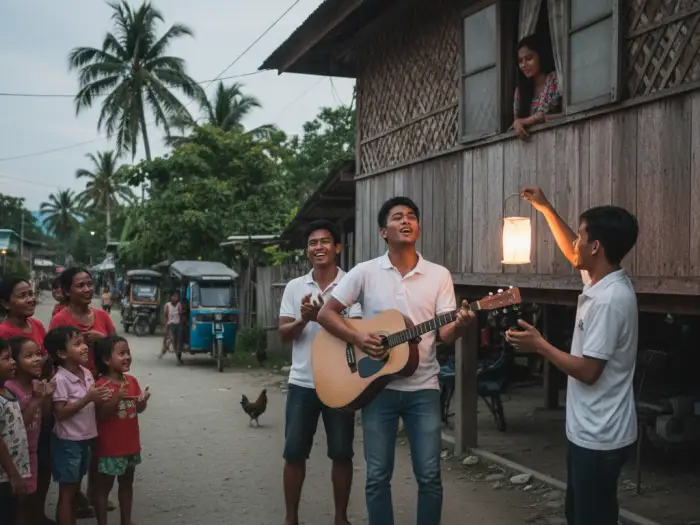
7. Harana and Serenades
The harana, or traditional serenade, is one of the most romantic Filipino courtship customs. In the past, a young man would gather his courage – and sometimes a guitar and friends – to sing outside the window of the woman he admired. More than just music, it was a display of sincerity, humility, and effort.
While modern dating apps and text messages have replaced the harana in many places, echoes of this custom survive. Couples still celebrate their love with music – from karaoke dedications to viral serenades online. The form may have changed, but the Filipino love for heartfelt gestures remains alive.
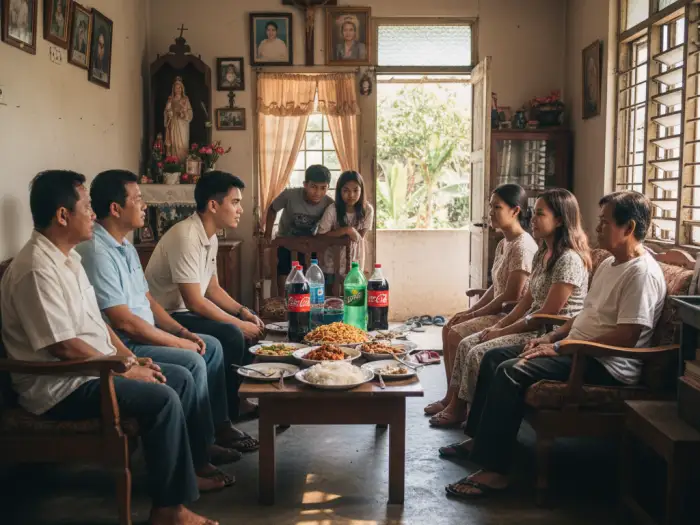
8. Pamamanhikan: Seeking Family Blessings
Another uniquely Filipino custom in marriage is pamamanhikan. This tradition involves the groom and his family formally visiting the bride’s home to ask for her parents’ blessing. Often accompanied by gifts or food, the visit signifies not just the union of two individuals but of two families.
Though some urban couples skip this step today, pamamanhikan is still practiced in many communities as a sign of respect. It reflects the Filipino belief that marriage is not only a private matter but also a family affair, built on mutual respect and harmony.
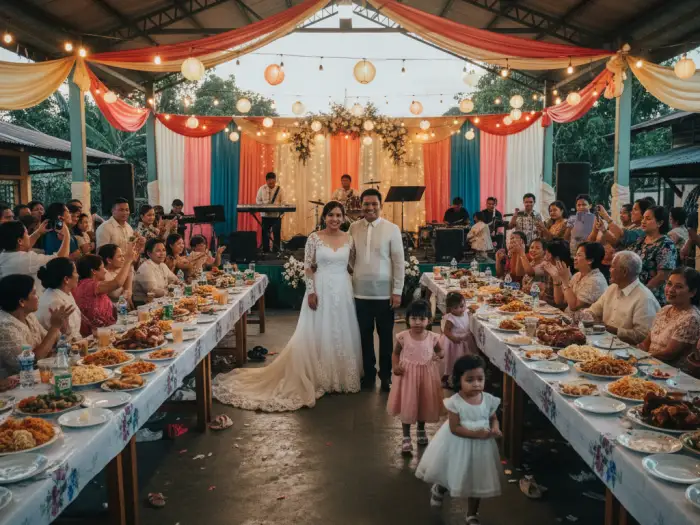
9. Weddings and Clan Celebrations
Filipino weddings are rarely small affairs. They often include an extended list of godparents (ninong and ninang), entire barangays invited to the reception, and traditions like the money dance, candle and veil ceremonies, and the releasing of doves. Each ritual carries symbolic meaning – prosperity, unity, or blessings for a long and happy life.
Even as modern wedding trends influence today’s ceremonies, these Filipino wedding traditions endure. They remind us that love is not only about two people but about the bonds that tie families and communities together. In the Filipino way, love is always larger than life.
🙏 Festivals, Faith, and Spiritual Traditions in the Philippines
Faith and celebration are at the core of Filipino life. Our archipelago is dotted with festivals and rituals that blend Indigenous roots, Spanish Catholic influence, and local creativity. These Filipino traditions are more than spectacles; they are living expressions of devotion, joy, and community pride.
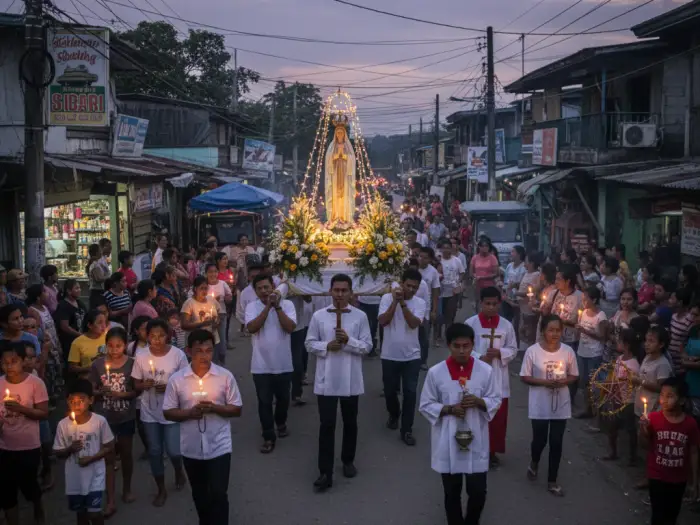
10. Religious Processions and Devotions
Every town in the Philippines has a patron saint, and honoring them is one of the country’s most vibrant customs and traditions. From the solemn Traslación of the Black Nazarene in Quiapo to colorful town processions during fiestas, Filipinos show their faith by walking together, singing hymns, and carrying images of saints through the streets.
These processions are not only acts of devotion but also powerful reminders of unity. They gather entire communities – from the devout elderly to playful children – under the shared spirit of belief and gratitude.
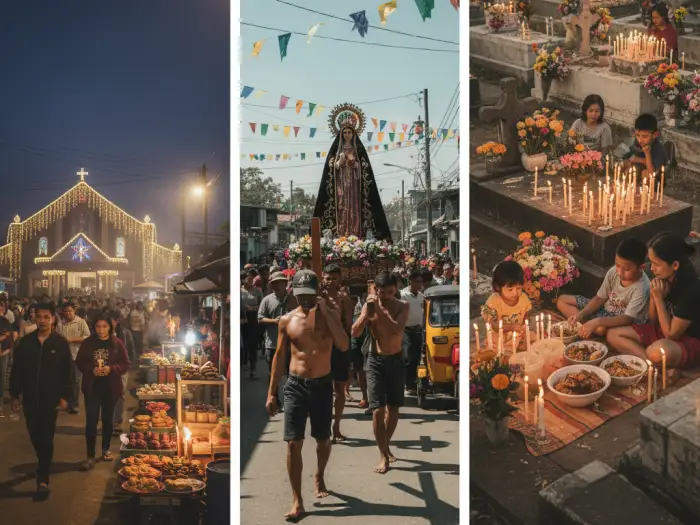
11. Simbang Gabi, Holy Week, and All Saints’ Day
Some of the most beloved Filipino faith traditions follow the calendar of the Catholic Church. Simbang Gabi, the nine dawn masses before Christmas, is a cherished custom where families rise early to attend mass together, often followed by enjoying bibingka and puto bumbong. Completing all nine masses is believed to grant a special wish, keeping alive a blend of faith and hope.
During Holy Week, Filipinos observe traditions like the pabasa (chanting of the Passion), senakulo (reenactments of Christ’s suffering), and Good Friday processions. Meanwhile, All Saints’ and All Souls’ Days transform cemeteries into lively reunions, with families lighting candles, offering prayers, and even sharing meals to honor departed loved ones.
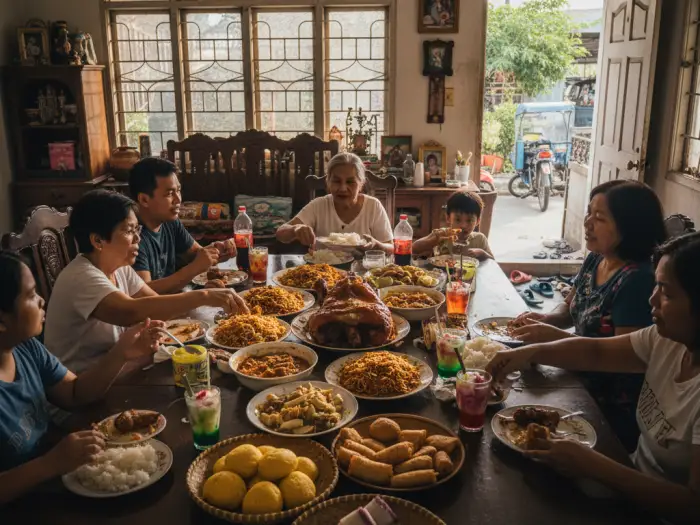
12. Food as Tradition and Symbol
In the Philippines, food is never just food – it’s culture, memory, and ritual. No fiesta is complete without lechon, which symbolizes abundance and hospitality. Pancit, served during birthdays, is believed to bring long life, while sticky rice delicacies (kakanin) during Christmas symbolize family closeness and unity.
These Filipino food traditions are deeply woven into faith and celebration. They remind us that meals are not only about nourishment but also about strengthening bonds – whether with family, community, or the divine.
🌞 Everyday Filipino Traditions in Daily Life
Not all customs are grand or tied to fiestas. Some of the most meaningful Filipino traditions are found in the little rituals of daily life – the gestures, words, and habits that make our culture unique. These practices may seem simple, but they carry deep values of thoughtfulness, respect, and connection.
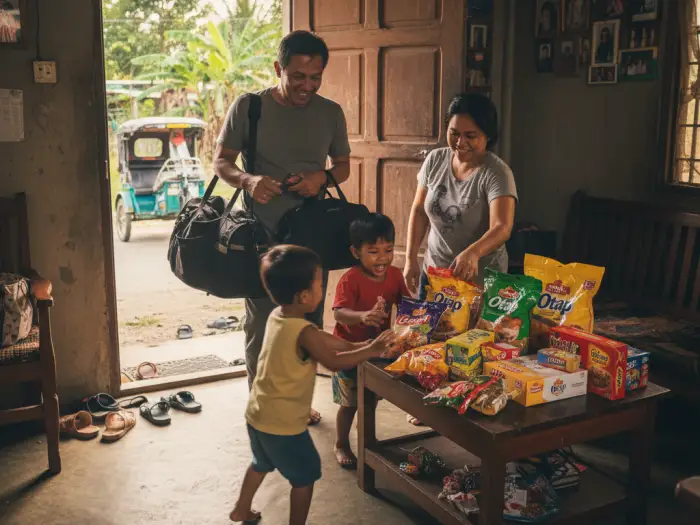
13. Pasalubong: Thoughtful Gift-Giving After Travels
One of the sweetest Filipino customs is pasalubong – bringing home gifts or treats after a trip. Whether it’s delicacies from the province, keychains from abroad, or even just favorite snacks, pasalubong is less about the item itself and more about the thought behind it. It says, “Naalala kita” – “I remembered you.”
This tradition strengthens bonds between families and friends, and even overseas Filipinos continue it when they return home from abroad.
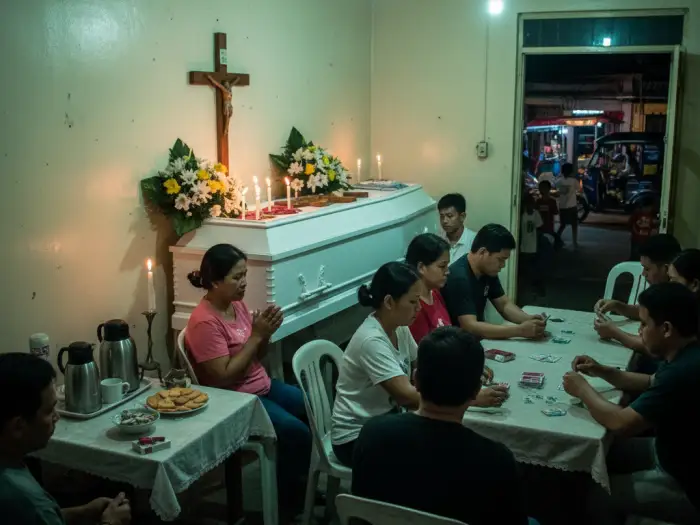
14. Wake Customs and Respect for the Dead
Respect for the departed is another deeply rooted Filipino tradition. Wakes often last several days, with friends and relatives keeping vigil, praying, and offering support to the bereaved family. The practice of pagpag – stopping somewhere else before going home from a wake – reflects the belief in not bringing spirits back to one’s house.
Every year, Filipinos also gather at cemeteries during Undas (All Saints’ and All Souls’ Day). Families clean tombs, light candles, and share meals, turning cemeteries into lively places of reunion and remembrance.
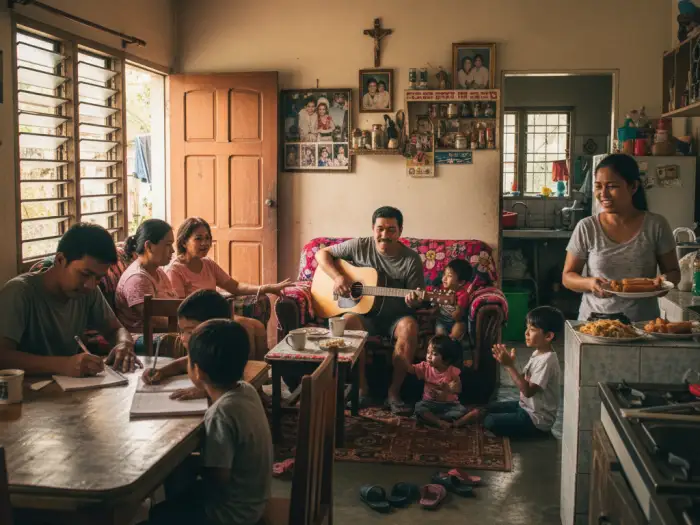
15. Kinship Terms in Daily Speech (Ate, Kuya, Tito, Tita)
In the Philippines, kinship goes beyond bloodlines. Using titles like Ate (older sister), Kuya (older brother), Tita (auntie), or Tito (uncle) even for non-relatives reflects the Filipino value of respect and inclusiveness. These everyday words make relationships warmer and blur the lines between family and community.
This linguistic tradition shows that in Filipino culture, almost everyone can be family – and everyone deserves to be treated with courtesy and care.
🌏 Why Filipino Customs and Traditions Matter Today
In a world that’s changing fast – with technology reshaping how we live and global culture blending into daily life – it’s easy to wonder if old customs still have a place. But the truth is, Filipino traditions matter now more than ever. They ground us, remind us of who we are, and connect us to something larger than ourselves.
These practices – from pagmamano to bayanihan, from pasalubong to fiesta celebrations – reflect the core Filipino values of respect, family, hospitality, faith, and resilience. Even as they adapt to modern times, the spirit behind them remains. A harana may turn into a love song sent through Messenger, or pasalubong may arrive via delivery apps, but the essence is unchanged: thoughtfulness, sincerity, and connection.
For Filipinos abroad, these customs become even more important. They are ways to carry home with them, whether through celebrating fiestas in foreign cities, calling elders with “po” and “opo,” or cooking lechon during Christmas. Our traditions remind us that no matter where we are, we belong to a culture that values people, relationships, and community above all.
These customs endure because they are not just rituals – they are the heartbeat of the Filipino identity. They make us feel at home, even when far away, and they ensure that the Filipino spirit continues to thrive across generations.
❓ FAQs About Filipino Customs and Traditions
What are the most important Filipino customs today?
Some of the most important Filipino customs include pagmamano (showing respect to elders), bayanihan (community spirit), celebrating fiestas, and traditions around family gatherings. These continue to define Filipino identity both at home and abroad.
Do younger generations still practice Filipino traditions?
Yes – while some practices have evolved, many traditions are still alive. Younger Filipinos may reinterpret customs (like digital harana or online pasalubong), but the values of respect, hospitality, and family remain strong.
Which Filipino customs are still observed by OFWs abroad?
Filipino workers overseas often bring traditions with them, such as celebrating Simbang Gabi, observing Undas, and hosting fiesta-style gatherings. These customs help keep a sense of home alive, even far from the Philippines.
Why do Filipinos put so much importance on family traditions?
Family is the foundation of Filipino culture. Traditions like Sunday reunions, pamamanhikan, and honoring elders preserve close ties across generations.
How do fiestas reflect Filipino culture?
Fiestas showcase the Filipino spirit of faith, joy, and generosity. They combine religious devotion with community bonding and highlight the importance of sharing food and hospitality.
Are Filipino customs influenced by other cultures?
Yes. Many traditions reflect a blend of Indigenous practices, Spanish colonial influence, and modern global culture. This mix makes Filipino customs unique and dynamic.
Do all regions in the Philippines share the same traditions?
Not always. While practices like bayanihan and pagmamano are widespread, regions also have unique customs tied to local dialects, festivals, and Indigenous rituals.
What role does food play in Filipino traditions?
Food is central – from lechon in fiestas to pancit for birthdays and kakanin during Christmas. Each dish often carries symbolic meaning tied to abundance, long life, or family closeness.
Are Filipino traditions disappearing because of modernization?
Some customs are less common today, but many continue in adapted forms. Modern life may change the way they look, but the values behind them endure.
Why is it important to preserve Filipino traditions?
Preserving traditions ensures that future generations remain connected to their roots. These customs carry the values of respect, community, and resilience that define the Filipino spirit.
✨ Living the True Filipino Spirit
Our customs and traditions are more than routines passed down through generations – they are the heartbeat of what it means to be Filipino. From the warmth of bayanihan to the reverence of pagmamano, these practices remind us that respect, faith, family, and community are at the core of our identity.
Just as our superstitions reveal how we make sense of luck, love, and life, our traditions show how we live those values every day. Together, they form a cultural tapestry that makes us proud, resilient, and uniquely Pinoy.
As the world changes, some customs may evolve, but the spirit behind them must continue. Because in every fiesta, every pasalubong, every “po” and “opo,” we see not only where we came from – but also the strength of who we are.
🧭 References
-
Bria Homes – Filipino Cultural Traditions at Home
-
Vogue PH – Holiday Traditions in Filipino Culture
-
Crown Asia – Modernized Filipino Traditions
-
Edamama – Top 10 Pinoy Traditions
-
Parenteam PH – Healthy Lifestyle from Traditions



